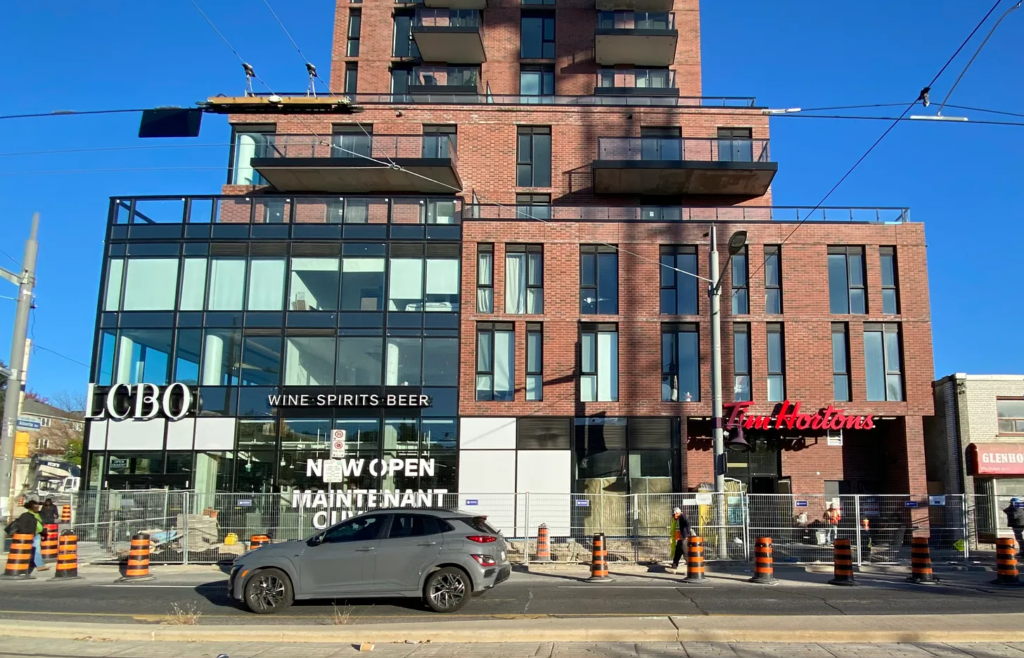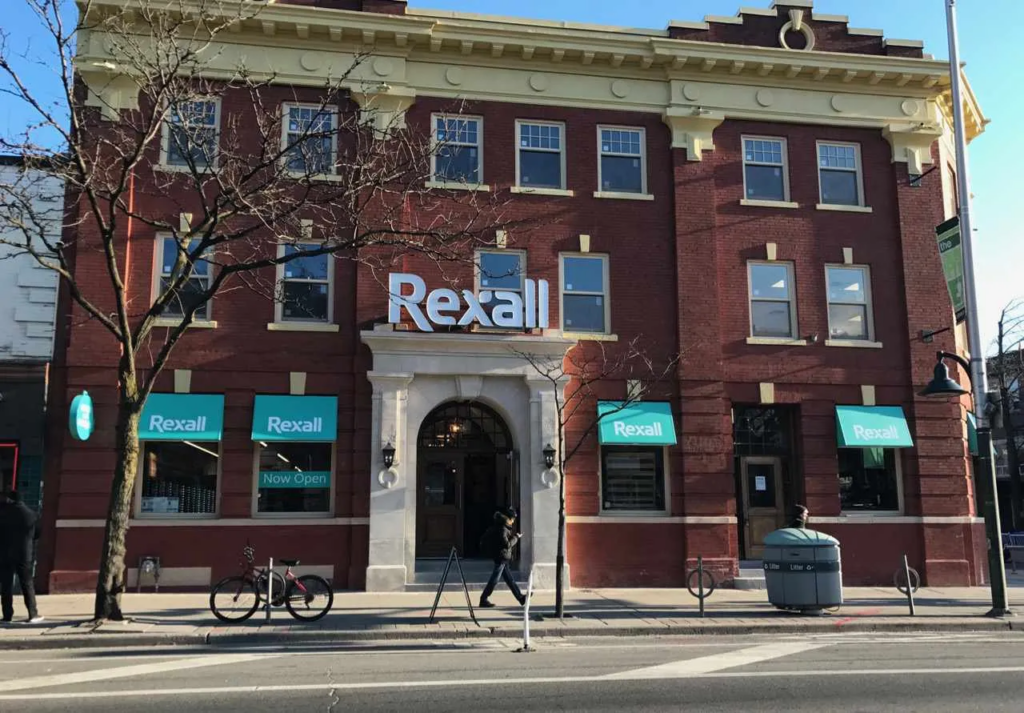Why our cities are becoming a corporate monoculture
Pulling another Lloyd Alter Carbon Upfront commentary. Been reading Lloyd for a number of years and going back to Slate’s The Fray. Those years could be measured in decades now.
I like the older building and worked on some of them in Chicago. The old Union Carbon and Carbide bldg. comes to mind. It became a Hard Rock venture. Later it was taken over becoming a St. Jane hotel. A Burnham Brothers-design Art Deco build by a corporation around 1920. Designed to look like a champagne bottle.
It was a thought at one time to study architecture.
Why our cities are becoming a corporate monoculture, Carbon Upfront, Lloyd Alter
There are many lovely coffee shops up and down St. Clair Ave West near my home. And now we are getting a branch of the big Brazilian coffee chain, Tim Hortons, on the ground floor of a new condo next to the new liquor store.
Twenty years ago, when I worked in prefab and was driving to the factory in Wingham, Ontario, a Timmys opened, and three restaurants on Main Street closed the next day, realizing that there was no point staying open and trying to compete. I suspect it will be different on St. Clair and that it will be Timmy that has trouble.
The problem is, big chains have taken over Toronto; the Hard Rock Cafe and the Brunswick Tavern both turned into drugstores. I assumed it is because the boomers are now more interested in buying Depends instead of drafts. Everywhere, it is banks and drugstores.
Michael Shuman, in his 2007 book The Small-Mart Revolution, explained why we should avoid the chains and support local businesses:
Going local does not mean walling off the outside world. It means nurturing locally owned businesses which use local resources sustainably, employ local workers at decent wages and serve primarily local consumers. It means becoming more self-sufficient and less dependent on imports. Control moves from the boardrooms of distant corporations and back into the community where it belongs.
Local businesses add so much more to our communities, and provide so many opportunities, and sometimes even a bit of humour. We should be doing everything we can to support them, and to keep out the big chains that are sucking up all the money.
A few years ago, I wrote about the problem of retail in new buildings, as we are seeing along St. Clair as it goes from two storeys to ten. It is a much-needed transition; the city needs housing, and it has great transit most of the time. The post was removed from Treehugger, but I am republishing it here because it looks at the reasons we get nothing but banks, government liquor stores, drugstores and Timmys in our new buildings.
Why Old Buildings Matter: New Buildings Create a Corporate Monoculture
It’s strange. You would think that with all the young people moving back into cities and renting apartments or buying condos, you would bet businesses starting that cater to them, particularly restaurants and bars. Given that their apartments are so small and their days so full of work, that the restaurants would be their dining rooms. In fact, the opposite is true. Instead, you get pretty much a monoculture of corporate chains and non-food services. Amy Pataki explains why in the Toronto Star:
Developers, property managers and individual businesses who own the retail spaces — condo corporations don’t — have their own concerns. “Bringing in a restaurant is usually a headache. Insurance goes up. Venting costs money,” says one development consultant.
Lenders who finance construction don’t like mom-and-pop restaurants either; as the developer of perhaps the most obnoxious condo in the trendiest part of Toronto noted unsurprisingly, “Let’s say McDonald’s came to us. The likelihood of McDonald’s paying the rent is dramatically different than a one-off restaurant owner.”
Where Jane Jacobs noted that new ideas need old buildings, I have written that “young people need old buildings”” You won’t find a vinyl record store or a tattoo shop in these new towers. Chris Hume picks up the story:
The streets of Toronto have become a reconfiguration of the expected brands, logos, colours and signs. Subway, Starbucks, Tims, McDonald’s, Shoppers and, at every corner, another bank branch have washed across the city like some tsunami of sameness, and condos are their enablers.
Besides the banks and the developers, he blames the condo owners too. Afraid of noise, smells, and people who are not condo owners like them, Chris says, “each condo is a NIMBY fortress and every management board its own Spanish Inquisition.” He quotes former city councillor Kyle Rae on the lack of diversity and choice:
They don’t want noise. They don’t want smells. They don’t want cooking on the premises . . . So you get the Tim Hortons, Starbucks and so on; they just truck in the supplies they need.
I have made the case before that “the creative economy thrives in older, mixed-use neighborhoods because they are generally more interesting and fun to be in and you don’t have to eat lunch at McDonalds.” As Chris notes,
The most vital streets in Toronto are those lined with small and often unremarkable two- or three-storey buildings that have two huge advantages: one, they are flexible and, two, they are older and, therefore, the mortgages tend to be paid off.
I know that many would put me in Felix Salmon’s class of “nostalgists and NIMBYs,” afraid of density and development. That’s not true; density is necessary and desirable. But there are ways to do it right, and there is what I call the Goldilocks density.
I am simply warning that monocultures are bad both in nature and in real estate development.





Didn’t Jane Jacobs write about this back in the 1960s?
The biggest driver these days is that landlords and their bankers want reliable rents at a certain level. That means that landlords cannot lower their rents without violating the terms of the loan. It also means that it is better for a landlord to have unoccupied space rather than risk loan problems with unreliable tenants. Banks, drugstores, and big chains all qualify. No one else does.
There’s also central place theory. Jacobs wrote about how 8th Street in Greenwich Village got taken over by shoe stores. That wasn’t bank driven. It just became the place to shop for shoes and run a shoe store. The shoe stores would pay a premium and drove out all the others.
My guess is that we need a serious collapse in real estate values. NYC was a seaport and manufacturing city. When shipping containerized and moved to New Jersey and manufacturing moved to the suburbs and overseas starting in the 1970s, the Garment District, Soho, Tribeca, the waterfronts and other neighborhoods collapsed. The cities were doomed and “creative” types moved in. Right now, the classic 9-5 business districts are in bad shape as companies reassess their office space needs. Perhaps we’ll see some bankruptcies and some new thinking that would generate housing and allow more interesting retail.
For your amusement: https://vividmaps.com/map-every-european-city/
It isn’t just the US. (I wonder what people said when every damned city built a cathedral, and they all looked alike.)
This feels like a pretty minor aesthetics issue than much of a serious problem. Sort of like Tim Horton’s is more popular than Alter feels it ought to be.
In Chicago, downtown redevelopment is trending toward conversion of commercial space (offices) into residential and retail in light of shrinkage of commuter office occupancy. Of necessity that will entail some gambling on restaurant type tenants.